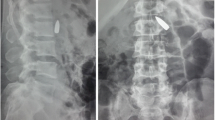Abstract
A 60-year-old Asian man who suffered penetrating thoracoabdominal injuries was admitted to our hospital in a state of shock. Because the results of a chest computed tomogram (CT) strongly suggested a left ventricular injury, an emergency thoracotomy was performed. A laceration of the left ventricle (3 cm) was sutured and was closed without cardiopulmonary bypass, and coexisting lacerations of the superior mesenteric artery (SMA) and small bowel were surgically repaired. During the procedure, cardiac arrest occurred, but the patient recovered without any apparent neurologic deficit. Postoperative examinations using echocardiogram, CT, and cardiac catheterization revealed a delayed rupture of the left ventricle. On the 28th day after surgery, he was transferred to another hospital for elective cardiac surgery. Primary management of penetrating cardiac injury is discussed in this report.
Similar content being viewed by others
References
Risa CA, Rhee P, Boyle EM, Maier RV, Jurkovich GG, Foy HM. Factors influencing outcome in stab wounds of the heart. Am J Surg 1995; 169: 553–6.
Mitchell ME, Muakkassa FF, Poole GV, Rhodes RS, Griswold JA. Surgical approach of choice for penetrating cardiac wounds. J Trauma 1993; 34: 17–20.
Macho JR, Markison RE, Schecter WP. Cardiac stapling in the management of penetrating injuries of the heart: rapid control of hemorrhage and decreased risk of personal contamination. J Trauma 1993; 34: 711–6.
Ivatury RR, Rohman M. The injured heart. Surg Clin North Am 1989; 69: 93–110.
Velmahos GC, Degiannis E, Souter I, Saadia R: Penetrating trauma to the heart: a relatively innocent injury. Surgery 1994; 115: 694–7.
Kavolius J, Golocovsky M, Champion HR. Predictors of outcome in patients who have sustained trauma and who undergo emergency thoracotomy. Arch Surg 1993; 128: 1158–62.
Jones RK, Wijngaarden MH, Talwar MK, Lovoulos C. Cardiopulmonary bypass for resuscitation after penetrating cardiac trauma. Ann Thorac Surg 1996; 61: 1244–5.
Cha EK, Mittal V, Allaben RD. Delayed sequelae of penetrating cardiac injury. Arch Surg 1993; 128: 836–41.
Katumi A, Henmi H, Masakio K, Ozeki K, Katou H, Otuka T et al. A successful surgical management in two patients with delayed rupture due to blunt cardiac trauma (in Japanese). Nihon Kyukyu Igaku Kantousi 1993; 14: 264–6.
Author information
Authors and Affiliations
Rights and permissions
About this article
Cite this article
Yamada, S., Yamazaki, M., Mori, K. et al. Successful surgical management of penetrating cardiac injury. Jpn J Thorac Caridovasc Surg 46, 953–956 (1998). https://doi.org/10.1007/BF03217853
Issue Date:
DOI: https://doi.org/10.1007/BF03217853




